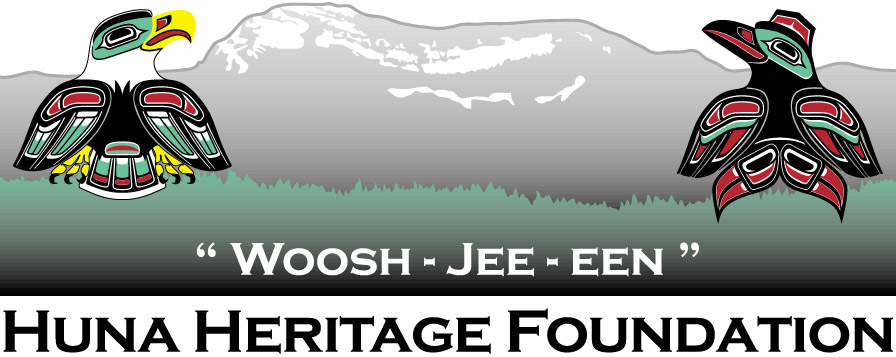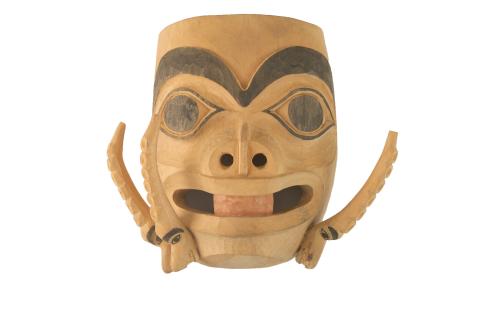Bear, Octopus and Land Otter Mask
From a block of wood an xút’aa (adze) would have been used to shape and block out the design. Once the design is blocked out, Amos would have used yoo katan litaa (crooked knives) to shape and finish the mask. Painting the mask could have been either done before or after carving the details in. In this case the mask was painted after the detail carving was completed.
Since this mask has animal crests that are usually used by an íxt’ e.g. náakw (octopus) and kóoshda (land otter) this piece would not have been used for common ceremonies.
The carver, Amos Wallace belonged to the Raven Moiety, T’akdeintaan Clan, X’áakw Hít of Hoonah and his Tlingit name was Jeet Yaaw Dustaa. Tlingit art has strict rules that need to be followed in order for the art produced to be considered Tlingit. Everyday items to expensive commissioned pieces followed these strict guidelines. For the sake of clarification Tlingits did not have a word or western concept for “art”, but through out the following text the word art is used for contemporary readers to facilitate understanding.
However, there was one person who could break these canonical rules and that was the íxt’ (shaman) and by the position and respect they were given they were allowed the freedom to be creative with their art and they produced some very unique objects and designs.
Every Tlingit village had an íxt’ (shaman). They could be male or female and they were able to communicate and control supernatural forces and beings. They could speak with the ancestors and could provide social, economic and ceremonial leadership for their villages. An íxt’ had the power to hurt other íxt’s or hurt any enemy of their people. They were considered benevolent and protective by their people and they used their knowledge and power to heal. The íxt’ was able to communicate and control supernatural forces and beings. Because of the status they were given they were not locked into the conventional social mores of common Tlingit people. Their art, personal appearance, as well as their lifestyle were distinctive and easily identified as characteristics of an íxt’. Ceremonial possessions of an íxt’ were considered spiritually very powerful and were only handled by the íxt’ or his/her helper. In some cases, the object carried so much power that it could not be viewed by common people. When an íxt’ died their body and their power possessions were placed in a specially carved ossuary box which was placed above ground in a place where the íxt’ could spiritually see any approaching enemies.
Bear mask, carved yellow cedar, eyes and eyebrows stained black, tongue stained red, holes on the side; with three composite creatures, representing the face of a land otter and the tentacles of an octopus, attached along the lower lip. Made by Amos Wallace.
Description:
Materials: Wood: Cedar > Yellow cedar; Paint/Drawing: Paints/Pigments > Wood stain
Techniques: General: Shaped/molded > Carved; Painted/Tinted/Coated > Painted
Dimensions: 19.0 cm x 23.5 cm x 10.0 cm
Iconography: Bear; Animal/animals; Face/faces; Otter; Octopus
Indian Arts and Crafts Board, Department of the Interior (Previous owner); Indian Arts and Crafts Board Demonstration Workshop (Juneau, Alaska) (IACB source)
Assoc. Parties:
Acquired by Indian Arts and Crafts Board representatives in 1962 when the artist was employed during IACB arts and crafts demonstrations at Juneau, Alaska; part of the IACB Headquarters collection (Department of the Interior, Washington, DC) until 2000 when it was transferred to NMAI.

